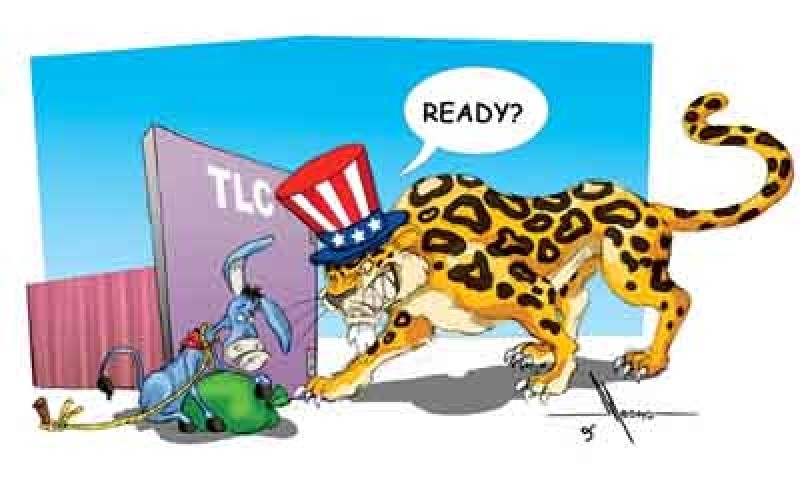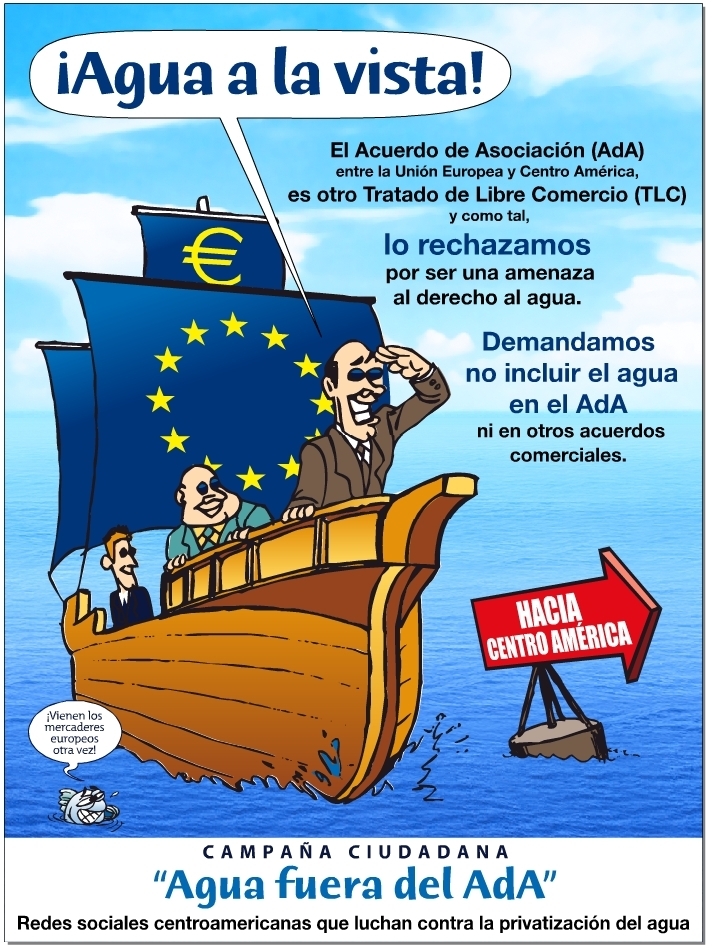The following was extracted from the text of Ch.7 in the process of editing down to 100,000 words forPluto.
The NAFTA Agreement came into force on 1st January 1994 and lifted restrictions on trade between the USA, Canada and Mexico over a period of fifteen years, although some specific production sectors were excluded. Broadly its goals were to eliminate barriers to trade, to facilitate cross-border movement of goods and services, to promote fair competition between the three nations, to increase investment opportunities and to provide protection of intellectual property rights within each nation.[1] NAFTA was promoted to increase jobs, raise living standards and improve environmental conditions in the three countries.[2]
These have been the oft-stated goals of most free trade treaties between nations until the more recent Association Agreement between the European Union and Central America. The Bolivarian Alliance for the Peoples of our America (ALBA) also offers a different model of trade between its participating countries. (For both these cases, see later sub-sections.)
Proponents and opponents of NAFTA continue to prosecute their cause regardless of the other’s arguments. For instance, former President of Mexico, Carlos Salinas de Gortari who negotiated NAFTA is reported as saying in 2002 that “The level of trade and type of products that crossed the borders silenced even the most ardent critics.”[3] The corporate lobbyists and government officials who he was addressing probably agreed with him, and certainly trade across the borders increased substantially. Those who hold a different view of the effects of NAFTA – the Mexican farmers, the utility workers and many other groups of workers who in the same year protested vehemently against the agreement – were certainly not silenced.
At the same time as the trade in products increased across the borders, the migration of Mexicans northwards also increased. It was explicitly stated by various protagonists of the treaty (including former US President Gerald Ford) that NAFTA would stem the migration of Mexicans northwards. In fact, as Jeff Faux reports, between 1990 and 2000, “the number of Mexican-born residents in the United States increased by more than 80 per cent.”[4]
NAFTA reduced import tariffs on a number of agricultural products which allowed the import of heavily subsidised US crops to be sold at a price less than the costs of production in Mexico. Mexico had previously used the tariffs to protect its farmers from cheaper, subsidised US exports. Timothy Wise (Director of the Research and Policy Programme at Tufts University) states that the effect of this was 2.3 million people leaving agriculture and heading to the cities and the USA.[5]
In manufacturing industry, before NAFTA Mexico’s laws required car manufacturers such as Ford, Chrysler, General Motors and Volkswagen to buy some of their components from Mexican producers. NAFTA prohibited such laws and car manufacturers supplied their assembly lines with parts from their own subsidiary companies, often from other countries. The result was that “Mexican auto-parts workers lost their jobs by the thousands.”[6]
Regarding NAFTA’s effects on the environment and environmental standards, Kevin Gallagher[7] of Tufts University’s Global Development and Environment Institute has examined the opposing arguments that NAFTA’s effect of increasing incomes would lead to environmental improvements against the idea that free trade would automatically worsen environmental conditions in Third World countries. In summary, he found that by all indicators, Mexico’s environmental institutions were “unable to keep up with the demands of the economic transformations occurring in the country.”[8] Spending on the environment fell, plant-level environmental inspections declined, and NAFTA’s environmental ‘side’ agreement was unable to match up to Mexico’s environmental problems. Gallagher warned that “trade-led growth without the proper environmental policies in place will not automatically lead to environmental improvements.”[9]
A further point of concern for objectors was the loss of national sovereignty. Salvadoran economist Raúl Moreno explains that under NAFTA “national governments which implement policies that limit the ability of private corporations to make profits – such as environmental laws or taxation regimes – can be sued before international tribunals.”[10] This became one of the major objections to later free trade treaties involving Central America.
The issue of communal land ownership by indigenous peoples is also pertinent to later trade treaties that involved Central American countries. Article 27 of the Mexican constitution granted indigenous peoples and landless campesinos communal land ownership. Before Mexico could join the NAFTA, it had to re-write Article 27 to facilitate the privatisation of communal lands. This ensured that indigenous peoples and campesinos swelled the ranks of objectors to NAFTA and was an important factor prompting the start of the Zapatista war against the Mexican state, on the same day as NAFTA came into force.
Even though NAFTA did not directly involve any of the seven Central American nations, the brief summary of its effects and arguments given above explains the strength of feeling of much of Central American civil society against free trade treaties which were later to involve their own nations. NAFTA alerted many sectors of civil society to the threats that they would face if similar treaties between their own countries and the USA were to be agreed.
[1] NAFTA and Inter-American Affairs website (2004) ‘Chapter One: Objectives’, www.mac.doc.gov/
[2] Public Citizen website, ‘North American Free Trade Agreement (NAFTA)’, www.citizen.org/trade/nafta/
[3] Jeff Faux (2003) ‘How NAFTA Failed Mexico’, The American Prospect, http://prospect.org/article/how-nafta-failed-mexico
[4] Ibid.
[5] Timothy Wise (January/February 2011) ‘Mexico: The Cost of US Dumping’, NACLA Report on the Americas, pp.47-8.
[6] David Bacon (September 2008) ‘Displaced People: NAFTA’s Most Important Product’, NACLA Report on the Americas, http://nacla.org/node/4980
[7] Kevin Gallagher (June 2004) ‘Economic Integration and the Environment in Mexico: Lessons for Future Trade Agreements’, Working Group on Development and Environment in the Americas, Discussion Paper No.6.
[8] Ibid., p.13.
[9] Ibid., p.17.
[10] Raúl Moreno (autumn 2005) ‘Avoiding free-fall’, Interact, Progressio, p.21.

